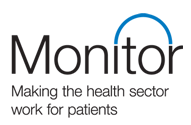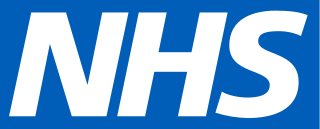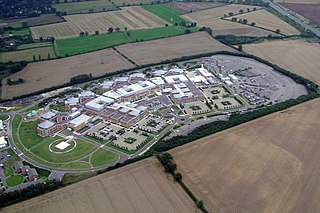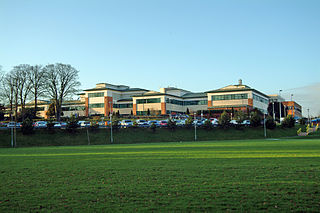
Monitor was an executive non-departmental public body of the Department of Health, responsible between 2004 and 2016 for ensuring healthcare provision in NHS England was financially effective. It was the sector regulator for health services in England. Its chief executive was Ian Dalton and it was chaired by Dido Harding. Monitor was merged with the NHS Trust Development Authority to form NHS Improvement on 1 April 2016.

Bedford Hospital is a 400-bed district general hospital located in the English town of Bedford, serving the Borough of Bedford and parts of Central Bedfordshire, run by the Bedfordshire Hospitals NHS Foundation Trust.

Sir David Nicholson is a public policy analyst and NHS Manager who is the Chair of Sandwell and West Birmingham Hospitals NHS Trust and Chair of Worcestershire Acute Hospitals NHS Trust. He was previously the Chief Executive of the National Health Service in England. He was appointed in October 2011 following the NHS reforms, having been seventh Chief executive of the NHS within the Department of Health since September 2006. He issued what has become known as the "Nicholson challenge" regarding the finances of the NHS. He retired from the role on 1 April 2014 in the wake of the Stafford Hospital scandal.

The West Midlands Ambulance Service University NHS Foundation Trust (WMAS UNHSFT) is responsible for providing NHS ambulance services within the West Midlands region of England. It is one of ten ambulance trusts providing England with emergency medical services, and is part of the National Health Service.

Furness General Hospital (FGH) is a hospital located in the Hawcoat area of Barrow-in-Furness, Cumbria, England. It is managed by the University Hospitals of Morecambe Bay NHS Foundation Trust.
The Health and Social Care Select Committee is a Departmental Select Committee of the British House of Commons, the lower house of the United Kingdom Parliament. Its remit is to examine the policy, administration and expenditure of the Department of Health and Social Care (DHSC) and its associated agencies and public bodies. The Clerks of the Committee are Previn Desai and Joanna Dodd.

Musgrove Park Hospital is a large NHS hospital located in Taunton, Somerset, England, run by Somerset NHS Foundation Trust. Originally a US Army General Hospital during the Second World War, it became an NHS hospital in 1951.

Broomfield Hospital is an acute district general hospital in Chelmsford, Essex. It is managed by the Mid and South Essex NHS Foundation Trust.

Criticism of the National Health Service (England) includes issues such as access, waiting lists, healthcare coverage, and various scandals. The National Health Service (NHS) is the publicly funded health care system of England, created under the National Health Service Act 1946 by the post-war Labour government of Clement Attlee. It has come under much criticism, especially during the early 2000s, due to outbreaks of antibiotic resistant infections such as MRSA and Clostridioides difficile infection, waiting lists, and medical scandals such as the Alder Hey organs scandal. However, the involvement of the NHS in scandals extends back many years, including over the provision of mental health care in the 1970s and 1980s (ultimately part of the reason for the Mental Health Act 1983), and overspends on hospital newbuilds, including Guy's Hospital Phase III in London in 1985, the cost of which shot up from £29 million to £152 million.

The National Health Service (NHS) is the publicly funded healthcare system in England, and one of the four National Health Service systems in the United Kingdom. It is the second largest single-payer healthcare system in the world after the Brazilian Sistema Único de Saúde. Primarily funded by the government from general taxation, and overseen by the Department of Health and Social Care, the NHS provides healthcare to all legal English residents and residents from other regions of the UK, with most services free at the point of use for most people. The NHS also conducts research through the National Institute for Health and Care Research (NIHR).

The Stafford Hospital scandal concerns poor care and high mortality rates amongst patients at the Stafford Hospital, Stafford, England, during the first decade of the 21st century. The hospital was run by the Mid Staffordshire NHS Foundation Trust, and supervised by the West Midlands Strategic Health Authority. It has been renamed County Hospital. The scandal also resulted in the resignation of NHS Chief Sir David Nicholson in 2013.

The Mid Staffordshire NHS Foundation Trust was a NHS foundation trust which managed two hospitals in Staffordshire, England:

Hinchingbrooke Hospital is a small district general hospital in Hinchingbrooke near Huntingdon, Cambridgeshire. Opened in 1983, it serves the Huntingdonshire area, and has a range of specialities as well as an emergency department and a maternity unit. The hospital is managed by the North West Anglia NHS Foundation Trust.

The Furness General Hospital scandal involves an investigation by Cumbria Constabulary and other government and public bodies into the deaths of several mothers and newborn babies, during the 2000s at Furness General Hospital (FGH) in Barrow-in-Furness, Cumbria, England. Cases date back to 2004, with a number of major incidents occurring in 2008. The death of Joshua Titcombe and a suppressed report by the Morecambe Bay NHS Trust brought the spotlight onto FGH in 2011 when investigations began. Claims of medical records being intentionally destroyed alongside the discovery of major wrongdoing on behalf of midwives led to threats of closure to the maternity ward.

Trafford General Hospital is a district general hospital in Davyhulme, Greater Manchester, England, managed by Manchester University NHS Foundation Trust.
Shrewsbury and Telford Hospital NHS Trust is the main provider of hospital services for Shropshire, Telford and Wrekin and North Powys. It runs the Royal Shrewsbury Hospital, the Princess Royal Hospital in Telford, Oswestry Maternity Unit, and Wrekin Community Clinic, Euston House, Telford, in Shropshire, England. It is one of a small number of English NHS Trusts which takes patients from over the border in Wales.
Mid Essex Hospital Services NHS Trust was an NHS trust which ran Broomfield Hospital in Chelmsford, St Peter's Hospital in Maldon, St Michael's Hospital in Braintree and formerly St John's Hospital in Chelmsford until its closure in 2010.
The University Hospitals of North Midlands NHS Trust was created on 1 November 2014. It runs Royal Stoke University Hospital, formerly run by the University Hospital of North Staffordshire NHS Trust and the County Hospital. It was formed after the dissolution of Mid Staffordshire NHS Foundation Trust. The trust is currently under the leadership of chair David Wakefield and chief executive Tracy Bullock.
Sir Robert Anthony Francis KC is a British barrister. He specialises in medical law, including medical and mental health treatment and capacity issues, clinical negligence and professional discipline. He has appeared as a barrister for and chaired several high-profile inquiries into medical controversies/scandals.
Healthcare in Staffordshire was the responsibility of six clinical commissioning groups until July 2022, covering Stafford & Surrounds, North Staffordshire, South East Staffordshire and Seisdon Peninsula, East Staffordshire, Cannock Chase, and Stoke-on-Trent.















